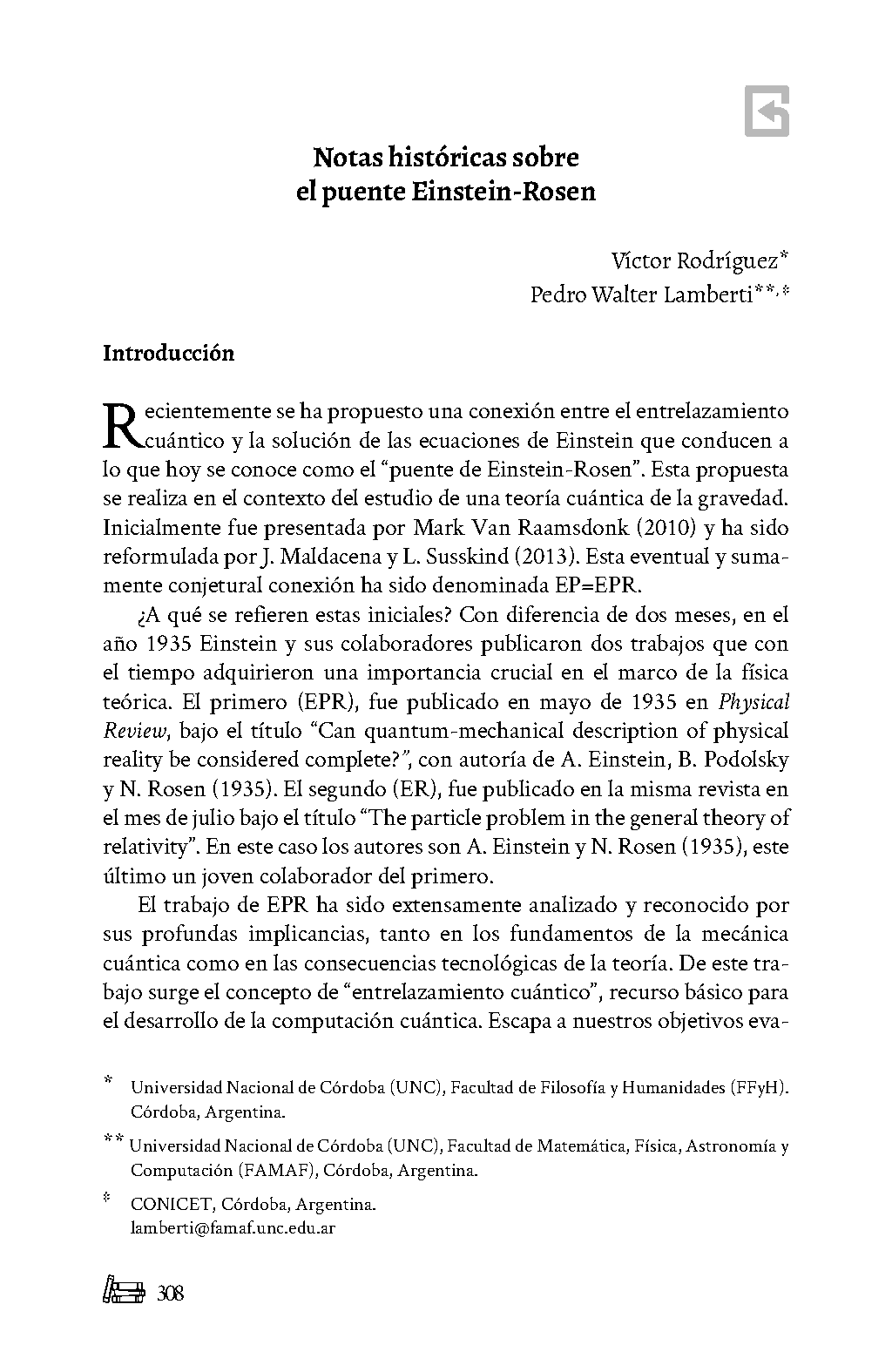Notas históricas sobre el puente Einstein-Rosen
Contenido principal del artículo
Resumen
Motivados en una posible conexión entre los trabajos de A. Einstein y colaboradores del año 1935, conocidos en la literatura como EPR y ER, investigamos algunos aspectos históricos del segundo trabajo, y que ha dado lugar a la solución de agujero de gusanos de la relatividad general.
Detalles del artículo
Sección

Esta obra está bajo una licencia internacional Creative Commons Atribución-NoComercial-SinDerivadas 4.0.
- Los autores/as conservarán sus derechos de autor y garantizarán a la revista el derecho de primera publicación de su obra, el cual estará simultáneamente sujeto a la Licencia de reconocimiento de Creative Commons que permite a terceros compartir la obra, siempre que se indique su autor y su primera publicación en esta revista.
- Los autores/as podrán adoptar otros acuerdos de licencia no exclusiva de distribución de la versión de la obra publicada (p. ej.: depositarla en un archivo digital institucional o publicarla en un volumen monográfico), siempre que se indique la publicación inicial en esta revista.
- Se permite y recomienda a los autores/as difundir su obra a través de Internet (p. ej.: en archivos digitales institucionales o en su página web) antes y durante el proceso de envío.
Cómo citar
Referencias
Curiel, E. (2019). Singularities and black holes. En E. N. Zalta (Ed.), The Stanford encyclopedia of philosophy (Spring 2019 edition). https://
plato.stanford.edu/archives/spr2019/entries/spacetime-singu-larities/
Eddington, A. S. (1918). Report on the relativity theory of gravitation. Londres: Fleetway Press.
Einstein, A. (1922). Bemerkung zu der Abhandlung von E. Trefftz: ‘Das statische Gravitationsfeld zweier Massenpunkte in der Einstein- schen Theorie’. Sitzungsberichte der Preußischen Akademie der Wissenschaften Physikalisch-Mathematische Klasse, 448-449.
Einstein, A. (1936). Physics and reality. Journal of the Franklin Institute, 221(3), 349-382.
Einstein, A., Infeld, L., & Hoffmann, B. (1938). The gravitational equations and the problem of motion. Annals of Mathematics, 39(1),65-100.
Einstein, A, Podolsky, B., & Rosen, N. (1935). Can quantum-mechanical description of physical reality be considered complete? Physical review, 47(10), 777-780.
Einstein, A, & Rosen, N. (1935). The particle problem in the general the- ory of relativity. Physical Review, 48(1), 73.
Flamm, L. (1916). Beiträge zur Einsteinschen Gravitationstheorie. Physikalische Zeitschrift 17, 448-454.
Gibbons G. (2015): Editorial note to: Ludwig Flamm, Contribution to Einstein’s theory of ravitation. General Relativity and Gravitation, 47, 71.
Havas, P. (1989). The early history of the “problem of motion” in general relativity. En D. Howard & J. Stachel (Eds.), Einstein and the history of general relativity (pp. 234-276). Boston: Birkhäuser.
Havas, P. (1993). The general-relativistic two-body problem and the Einstein-Silberstein controversy. En J. Earman, M. Janssen, & J. D. Norton (Eds.), The attraction of gravitation: New studies in the history of general relativity (vol. 1, pp. 88-125). Springer Science & Business Media.
Langevin, P. (1908). The relations of physics of electrons to other branch- es of science. En H. J. Rogers (Ed.), International congress of arts and science (Vol. VII): Physics and chemistry (pp. 121-156). Lon- don; New York: University Alliance. (Obra original presentada en 1904)
Maldacena, J., & Susskind, L. (2013). Cool horizons for entangled black holes. Fortschritte der Physik, 61(9), 781-811.
Misner, C. W., & Wheeler, J. A. (1957). Classical physics as geometry. Annals of Physics, 2(6), 525-603.
Poincaré, H. (1917). La science et l’hypothèse. Paris: Flammarion. (Obra original publicada en 1906)
Silberstein, L. (1936). Two-centers solution of the gravitational field equations, and the need for a reformed theory of matter. Physical Review, 49(3), 268.
Trefftz, E. (1922). Das statische Gravitationsfeld zweier Massenpunkte in der Einsteinschen Theorie. Mathematische Annalen 86, 317-326.
Van Raamsdonk, M. (2010). Building up spacetime with quantum en- tanglement. General Relativity and Gravitation, 42(10), 2323-2329.
Weyl, H. (1928) Philosophie der Mathematik und Naturwissenschaft. En A. Bäumler & M. Schröter, Handbuch der Philosophie. Munich: Leibniz Verlag

